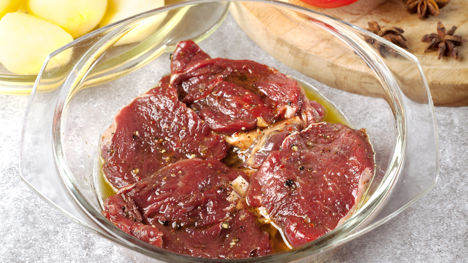Beef is delicious enough served simply with a little salt and pepper. But to take it to the next level, dry rubs, marinades and brines can impart subtle flavours and actually improve the texture of the meat. However, before you start throwing the contents of your spice cupboard over a prime cut, there are some guidelines you should follow to get the most out of the process.
Paul Foster is the chef-owner of Salt, in Stratford-upon-Avon, and certainly knows how to make the most of beef. His tips are vital when creating rubs, marinades and brines at home; use them incorrectly and you could end up with a poor flavour or even mushy meat. The main thing to remember is to use the best quality beef you can afford – rubs, marinades and brines are incredibly versatile and allow you to add almost any flavour you want, but they should enhance the meat rather than cover up its quality.
Dry rubs
Dry rubs are a mixture of seasonings and spices rubbed onto the outside of the meat. Including salt will kickstart the process of osmosis, absorbing moisture out of the meat and creating a brine, which if left long enough will break down some of the fibres in the beef and eventually work its way back in, carrying any additional flavours with it. If you’re planning to include salt in your dry rub, be sure to use coarse salt – finely ground table salt will draw too much moisture out of the beef too quickly and can cause a tough texture.
In terms of spices and other flavours, Paul says you can use whatever you like, but he prefers to keep things simple and subtle. An equal quantity of salt and sugar stops the salt from overpowering everything, and then ground cinnamon and cumin lend a lingering earthy warmth. Paul also recommends using star anise, or a pinch of smoked paprika (finished with a little sherry vinegar after the beef is cooked).
Once you’ve chosen your spices and seasonings, apply the dry rub to your beef and leave it for twelve hours in the fridge. Don’t be tempted to add the rub right before cooking – it will either have no effect or, even worse, leave pools of moisture on the surface of the meat which will prevent it from cooking properly. After the twelve hours, wash any remaining rub off, dry the meat thoroughly and cook. The flavour of the spices won’t be overbearing but will help enhance the beef itself.
Marinades
Using a marinade is another way to impart flavours into beef, but they’re not as effective as you might think. Paul says no oil-based marinade will ever penetrate or tenderise meat – it will only affect the surface as oil and water don’t mix. But it’s a good idea if you want a very subtle flavour – use fresh ingredients such as garlic, rosemary and thyme on a steak, for instance, and you’ll be able to taste them in the final dish.
If you’re looking to incorporate an acidic or citrus flavour to your beef, then Paul recommends steering clear of marinades – using citrus juices or vinegars can break down the surface of the meat too much, turning them mushy. Instead, he recommends adding lemon or lime zest to a dry rub.
Brines
Brining is the best way to get additional flavours to permeate right through a piece of beef, instead of just the outer layers. This is osmosis in action – a process that happens on a smaller scale with dry rubs that include salt. The salty brine will replace the water already in the cells of the meat, along with any other flavours infused into the liquid.
When making a brine for beef, it should be quite light and under ten percent salt to water. Prime cuts should be very lightly brined (between one and seven percent salt), whereas larger, fattier cuts such as brisket need something a little stronger (seven to ten percent). Powerful, punchy spices work well in brines, and Paul recommends star anise and fennel seeds in particular, but you can include anything you like. Heat the brine mixture until all the salt has dissolved and the spices have infused their flavours into the liquid, then cool and ensure your meat is fully submerged before placing in the fridge.
The length of time needed to fully brine meat depends entirely on the cut and your desired texture. As a starting point, however, always aim for at least one hour in the fridge. Individual cuts like steaks should be ready after three hours, whereas larger, fattier cuts can be left for up to two days. Be aware that brining can affect the texture as well as the flavour of beef, and leaving it too long can make it very soft, so it’s better to start light and work your way up instead of the other way around.
Get in touch
Please sign in or register to send a comment to Great British Chefs.


